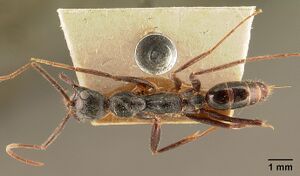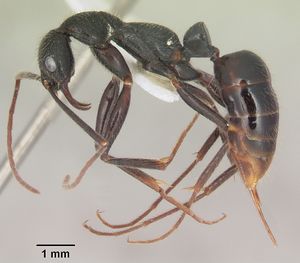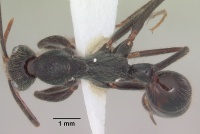Leptogenys stuhlmanni
| Leptogenys stuhlmanni | |
|---|---|

| |
| Scientific classification | |
| Kingdom: | Animalia |
| Phylum: | Arthropoda |
| Class: | Insecta |
| Order: | Hymenoptera |
| Family: | Formicidae |
| Subfamily: | Ponerinae |
| Tribe: | Ponerini |
| Genus: | Leptogenys |
| Species group: | stuhlmanni |
| Species: | L. stuhlmanni |
| Binomial name | |
| Leptogenys stuhlmanni Mayr, 1893 | |
| Synonyms | |
| |
Besides its occurrence in Mohéli, L. stuhlmanni is also known from the east coast and southern portions of Africa, where itis restricted to open areas and dry forest habitats.
Identification
A lone member of the stuhlmanni species group. Rakotonirina and Fisher (2014) - Worker. Mandible elongate and narrow, not capable of closing tightly against the clypeus; dorsum of body covered with erect hairs; eye large, with maximum diameter greater than widest portion of antennal scape; third antennal segment approximately twice as long as the second; dorsum of head smooth apart from scattered punctures; pronotum dorsally weakly sculptured; constriction between third and fourth abdominal segments indistinct.
Leptogenys stuhlmanni is large and may be confused with the few large species of the incisa group due to its elongate mandible and the gap between the clypeus and the mandibles when the latter are closed. But L. stuhlmanni’s body surface is generally smooth and shining between punctures and its particularly long third antennal segment provides a clear distinction from these other species. Key to Malagasy Leptogenys
Keys including this Species
Distribution
Latitudinal Distribution Pattern
Latitudinal Range: -3.96667° to -4.50222°.
| North Temperate |
North Subtropical |
Tropical | South Subtropical |
South Temperate |
- Source: AntMaps
Distribution based on Regional Taxon Lists
Afrotropical Region: Comoros, Eritrea, Kenya, Mozambique (type locality), Sudan, United Republic of Tanzania.
Distribution based on AntMaps
Distribution based on AntWeb specimens
Check data from AntWeb
Countries Occupied
| Number of countries occupied by this species based on AntWiki Regional Taxon Lists. In general, fewer countries occupied indicates a narrower range, while more countries indicates a more widespread species. |

|
Estimated Abundance
| Relative abundance based on number of AntMaps records per species (this species within the purple bar). Fewer records (to the left) indicates a less abundant/encountered species while more records (to the right) indicates more abundant/encountered species. |

|
Biology
|
Castes
Images from AntWeb
   
| |
| Paralectotype of Leptogenys comorensis. Worker. Specimen code casent0101871. Photographer April Nobile, uploaded by California Academy of Sciences. | Owned by MHNG, Geneva, Switzerland. |
   
| |
| Paralectotype of Leptogenys comorensis. Worker. Specimen code casent0101876. Photographer April Nobile, uploaded by California Academy of Sciences. | Owned by MHNG, Geneva, Switzerland. |
   
| |
| Paralectotype of Leptogenys comorensis. Worker. Specimen code casent0101904. Photographer April Nobile, uploaded by California Academy of Sciences. | Owned by MHNG, Geneva, Switzerland. |
   
| |
| Paralectotype of Leptogenys comorensis. Worker. Specimen code casent0101967. Photographer April Nobile, uploaded by California Academy of Sciences. | Owned by MHNG, Geneva, Switzerland. |
   
| |
| Paralectotype of Leptogenys comorensis. Worker. Specimen code casent0101968. Photographer April Nobile, uploaded by California Academy of Sciences. | Owned by MHNG, Geneva, Switzerland. |
   
| |
| Not part of a type series. Worker. Specimen code casent0104565. Photographer April Nobile, uploaded by California Academy of Sciences. | Owned by ZMHB, Berlin, Germany. |
   
| |
| Worker. Specimen code sam-hym-c008614. Photographer Michele Esposito, uploaded by California Academy of Sciences. | Owned by SAMC, Cape Town, South Africa. |
Images from AntWeb
   
| |
| Paralectotype of Leptogenys comorensis. Worker. Specimen code casent0101826. Photographer April Nobile, uploaded by California Academy of Sciences. | Owned by MHNG, Geneva, Switzerland. |
Nomenclature
The following information is derived from Barry Bolton's Online Catalogue of the Ants of the World.
- stuhlmanni. Leptogenys (Lobopelta) stuhlmanni Mayr, 1893: 198 (w.) MOZAMBIQUE. Santschi, 1914b: 55 (m.). Senior synonym of comorensis: Bolton, 1975a: 262.
- comorensis. Leptogenys comorensis Forel, 1907g: 76 (w.) COMORO IS. Junior synonym of stuhlmanni: Bolton, 1975a: 262.
Unless otherwise noted the text for the remainder of this section is reported from the publication that includes the original description.
Leptogenys stuhlmanni is the only species of the stuhlmanni group that has been found in the Malagasy region, on Mohéli Island of the Comoros. Interestingly, this species was collected only once on this island, sometime between 1903 and 1905; it has not been seen in the region since. Even the use of modern collecting methods during the 2008 arthropod inventory project across the Comoros Islands did not catch any workers of L. stuhlmanni. These results suggest that this species requires very restricted environmental conditions, and the destruction of natural forest habitats in Mohéli might have caused it to go locally extinct. Leptogenys comorensis, a junior synonym of L. stuhlmanni (by Bolton 1975 and confirmed by this study), was first described by Forel (1907) when he received specimens from Voeltzkow after a trip to the Comoros Islands and Madagascar between 1903 and 1905. These specimens were collected from Mohéli in the Comoros and Lake Alaotra in central eastern Madagascar. In his original description, Forel doubted the pattern of distribution of this species and doubted its presence at Lake Alaotra. During the course of this study, we were not able to examine the worker specimen stated to be found in Lake Alaotra, as its location is unknown. Also, the extensive ant inventories during the past 15 years in Madagascar have caught no worker of L. stuhlmanni, suggesting that Forel was right to doubt the presence of this species in Madagascar.
Description
Worker
Rakotonirina and Fisher (2014) - (1 specimen). HW: 1.58, HL: 1.76, CI: 90, SL: 2.30, SI: 145, PW: 1.14, WL: 3.26, PNH: 0.80, PNL: 0.77, PNW: 0.59, DNI: 77, LNI: 134.
Head longer than broad, distinctly diverging from back to front; posterior margin roughly straight. Mandible long and feebly curved near bases, with parallel outer and inner margin; blades generally same width from bases to apices and not able to close tightly against anterior margin of clypeus; basal groove a broad sulcus. In full-face view, eye large, maximum diameter twice as large as maximum width of scape; location not breaking outline of lateral cephalic margin. Antennal scape very long, more than one third its length extending beyond posterior border of head; third antennal segment strikingly elongate, length more than twice the length of the second. Clypeus projecting anteriorly and strongly converging into narrowly triangular lobe; median clypeal carina long and sharp. In dorsal view, mesonotum distinctly longer than broad and metanotal groove present. In profile, propodeal posterior margin rounded, without toothlike lobe or blunt angle; propodeal spiracle elongate. Petiolar node as long as high in lateral view; in dorsal view node longer than broad, with lateral margin feebly converging. Helcium situated near lateroventral angle of anterior margin of third abdominal segment. Constriction between third and fourth abdominal segments indistinct. Dorsum of head, promesonotum, petiolar node and gastral tergites generally smooth and shining apart from punctures. Punctures on body vary in size and space, ranging from much larger and closely spaced from head dorsum to very small, scattered punctures on third and fourth abdominal segments. Rugulae may be present in front of eyes. Propodeal dorsum with faintly effaced, fine rugulae between small punctures; propodeal declivity transversely striate or with rugulae. Erect hairs present from antennae and head dorsum to gaster. Body color dark brown, with light brown tip of gaster; appendages brown and become light brown towards apices.
Type Material
Rakotonirina and Fisher (2014) - Syntype workers, Mozambique, Quilimane (Stuhlmann) [location of type not known].
References
- Bolton, B. 1975a. A revision of the ant genus Leptogenys Roger (Hymenoptera: Formicidae) in the Ethiopian region with a review of the Malagasy species. Bull. Br. Mus. (Nat. Hist.) Entomol. 31: 235-305.
- Mayr, G. 1893. Formiciden von Herrn Dr. Fr. Stuhlmann in Ost-Afrika gesammelt. Jahrbuch der Hamburgischen Wissenschaftlichen Anstalten 10 (1892): 193-201. (31.xii).1893.
- Rakotonirina, J.C. & Fisher, B.L. 2014. Revision of the Malagasy ponerine ants of the genus Leptogenys Roger (Hymenoptera: Formicidae). Zootaxa 3836, 1-163.
References based on Global Ant Biodiversity Informatics
- Arnold G. 1915. A monograph of the Formicidae of South Africa. Part I. Ponerinae, Dorylinae. Annals of the South African Museum 14: 1-159.
- Bolton B. 1975. A revision of the ant genus Leptogenys Roger (Hymenoptera: Formicidae) in the Ethiopian region with a review of the Malagasy species. Bulletin of the British Museum (Natural History). Entomology 31: 235-305.
- Emery C. 1911. Hymenoptera. Fam. Formicidae. Subfam. Ponerinae. Genera Insectorum 118: 1-125.
- Fisher B. L. 1997. Biogeography and ecology of the ant fauna of Madagascar (Hymenoptera: Formicidae). Journal of Natural History 31: 269-302.
- Forel A. 1907. Ameisen von Madagaskar, den Comoren und Ostafrika. Wissenschaftliche Ergebnisse. Reise in Ostafrika 2: 75-92.
- Forel A. 1910. Ameisen aus der Kolonie Erythräa. Gesammelt von Prof. Dr. K. Escherich (nebst einigen in West-Abessinien von Herrn A. Ilg gesammelten Ameisen). Zoologische Jahrbücher. Abteilung für Systematik, Geographie und Biologie der Tiere 29: 243-274.
- Forel A. 1914. Formicides d'Afrique et d'Amérique nouveaux ou peu connus. Bulletin de la Société Vaudoise des Sciences Naturelles 50: 211-288.
- Garcia F.H., Wiesel E. and Fischer G. 2013.The Ants of Kenya (Hymenoptera: Formicidae)Faunal Overview, First Species Checklist, Bibliography, Accounts for All Genera, and Discussion on Taxonomy and Zoogeography. Journal of East African Natural History, 101(2): 127-222
- IZIKO South Africa Museum Collection
- Prins A. J. 1965. Notes on African Formicidae (Hymenoptera) - 1. Journal of the Entomological Society of Southern Africa 27: 153-159.
- Rakotonirina J. C., and B. L. Fisher. 2014. Revision of the Malagasy ponerine ants of the genus Leptogenys Roger (Hymenoptera: Formicidae). Zootaxa 3836 (1): 001163.
- Weber N. A. 1943. The ants of the Imatong Mountains, Anglo-Egyptian Sudan. Bulletin of the Museum of Comparative Zoology 93: 263-389.
- Wheeler W. M. 1922. Ants of the American Museum Congo expedition. A contribution to the myrmecology of Africa. IX. A synonymic list of the ants of the Malagasy region. Bulletin of the American Museum of Natural History 45: 1005-1055
- Wheeler W. M. 1922. Ants of the American Museum Congo expedition. A contribution to the myrmecology of Africa. VIII. A synonymic list of the ants of the Ethiopian region. Bulletin of the American Museum of Natural History 45: 711-1004

